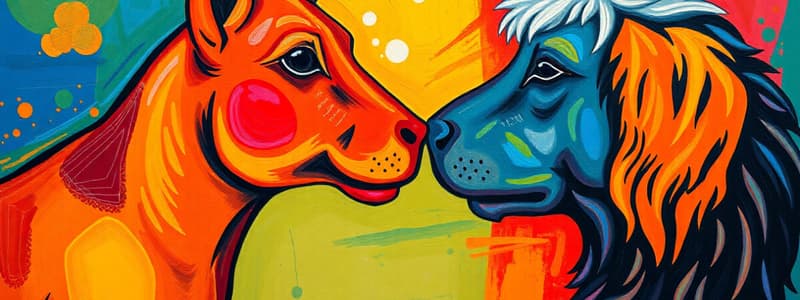Podcast
Questions and Answers
According to the opponent-process theory of emotional behavior, what happens to the 'b process' with repeated exposure to a stimulus?
According to the opponent-process theory of emotional behavior, what happens to the 'b process' with repeated exposure to a stimulus?
- The 'b process' becomes stronger and longer in duration. (correct)
- The 'b process' becomes weaker and shorter in duration.
- The 'b process' disappears entirely after sufficient exposure.
- The 'b process' remains constant in intensity and duration.
In the context of Pavlovian fear conditioning, what is the typical unconditioned response (UR)?
In the context of Pavlovian fear conditioning, what is the typical unconditioned response (UR)?
- The presentation of a neutral stimulus.
- A freezing response or increased heart rate. (correct)
- The seeking of food or reward.
- The suppression of appetite.
Why are control procedures necessary in classical conditioning experiments?
Why are control procedures necessary in classical conditioning experiments?
- To rule out the possibility that observed responses are due to sensitization or pseudo-conditioning rather than true associative learning. (correct)
- To ensure that the unconditioned stimulus (US) is always presented before the conditioned stimulus (CS).
- To eliminate any individual differences between subjects.
- To maximize the intensity of the conditioned response (CR).
In the context of measuring conditioned responses, what does the magnitude of the response typically indicate?
In the context of measuring conditioned responses, what does the magnitude of the response typically indicate?
Which of the following is a typical method for measuring Pavlovian inhibitory conditioning?
Which of the following is a typical method for measuring Pavlovian inhibitory conditioning?
What is the primary ethical consideration when utilizing animal models in research?
What is the primary ethical consideration when utilizing animal models in research?
Which of the following best describes the concept of a reflex, as it was understood historically?
Which of the following best describes the concept of a reflex, as it was understood historically?
In the context of elicited behavior, what is the purpose of the 'Head Turning' reflex observed in infants when there is a touch on their cheek?
In the context of elicited behavior, what is the purpose of the 'Head Turning' reflex observed in infants when there is a touch on their cheek?
A researcher is designing an experiment to study learning in rats. Which factor should be considered to ensure the study yields informative results?
A researcher is designing an experiment to study learning in rats. Which factor should be considered to ensure the study yields informative results?
How does non-associative learning differ from associative learning?
How does non-associative learning differ from associative learning?
A loud noise is repeatedly presented to a subject. Initially, the subject shows a strong startle response, but over time, the response diminishes. Which of the following is NOTconsidered a possible explanation for this?
A loud noise is repeatedly presented to a subject. Initially, the subject shows a strong startle response, but over time, the response diminishes. Which of the following is NOTconsidered a possible explanation for this?
In the context of sensitization, how does the intensity of a stimulus typically affect the magnitude of the response?
In the context of sensitization, how does the intensity of a stimulus typically affect the magnitude of the response?
According to the Dual Process Theory, what determines whether habituation or sensitization will occur in response to a repeated stimulus?
According to the Dual Process Theory, what determines whether habituation or sensitization will occur in response to a repeated stimulus?
Flashcards
Animal Models
Animal Models
Using animals in research to understand biological and behavioral processes.
Reflex
Reflex
Involuntary response to a specific stimulus.
Descartes Reflex
Descartes Reflex
Involuntary response to stimulus mediated by a neural pathway.
Elicited Behavior
Elicited Behavior
Signup and view all the flashcards
Learning
Learning
Signup and view all the flashcards
Habituation
Habituation
Signup and view all the flashcards
Sensitization
Sensitization
Signup and view all the flashcards
Dual Process Theory
Dual Process Theory
Signup and view all the flashcards
Opponent Process Theory
Opponent Process Theory
Signup and view all the flashcards
Fear Conditioning
Fear Conditioning
Signup and view all the flashcards
Appetitive Conditioning
Appetitive Conditioning
Signup and view all the flashcards
Inhibitory Pavlovian Conditioning
Inhibitory Pavlovian Conditioning
Signup and view all the flashcards
CS-US Contingency
CS-US Contingency
Signup and view all the flashcards
Study Notes
- PSYC 351 - Midterm I Study Notes
Lesson 1: The Use of Animal Models
- Animal models are critical for experimental control, studying the evolution of learning, and understanding the biological bases of learning.
- (Neuro)biology of learning cannot be understood without studying learning at the behavioral level.
- Animal models enable the study of normal emotion acquisition, while human studies focus on reducing abnormal emotions.
- Focus on relevant features and functions to identify points of similarity between animal models and humans.
Ethics
- Ethics are a key consideration in the humane treatment of laboratory animals.
- Ethical treatment and the right to benefit from animal experimentation are important discussions.
- Russell & Burch proposed the three Rs: Replacement, Reduction, and Refinement, as alternatives to animal experimentation.
Lesson 2: History - Historical Perspectives
- The key question is: Are there any constraints on learning and behavior?
Empiricism
- Empiricism posits that knowledge is gained through experience.
- John Locke (1632-1704) introduced the concept of "Tabula Rasa," stating the mind is a blank slate at birth.
- All knowledge is built upon sensory experience, starting with simple sensations.
- Sensations combine to form complex ideas through associations.
- This contrasts with Immanuel Kant's theory of a prioris.
The Rules of Association - Primary (Aristotle)
- Contiguity: If two events repeatedly occur together in space or time, they become associated.
Nativism
- Nativism contrasts empiricism
- René Descartes (1596-1650) introduced Dualism, stating the mind is distinct from the body.
- Descartes believed the mind has innate knowledge
- The mind is the source of all voluntary behavior (conscious intent, like Thomas Hobbes' hedonism).
- The body controls involuntary behavior in response to external stimuli via a mechanistic/reflexive process.
- Reflexes mediate involuntary behavior.
What is a Reflex?
- A reflex constitutes an automatic reaction to external stimuli, connecting a stimulus with a response.
Descartes Reflex - Involuntary Behavior
- There is an automatic connection between a stimulus and a response.
- Sensory organs detect a stimulus.
- 'Animal spirits' travel up the nerves (hollow tubes) to the 'mind' via the pineal gland.
- Agitation travels the same route to the muscles, causing them to swell and resulting in movement.
- Key point: reflexes are innate, fixed by the nervous system.
Elicited Behavior
- Reflexes are a form of elicited behavior, which encompasses innate and learned behaviors in response to a stimulus.
- Presentation of a stimulus triggers a predictable response.
- Simple reflexes are examples of elicited behavior.
- Complex behavioral sequences are often comprised of a series of reflexes working in concert.
Specificity of Response: Reflex Arc
- Complex behaviors may require coordinated reflexes
Modal Action Patterns (MAPS)
- MAPS are species-typical behavior, such as feeding, mating, social behaviors, territorial defense, aggression, and prey capture.
Early Empirical Investigations
- Sechenov studied release from inhibition and the role of stimulus intensity in reflexes.
- Pavlov studied the physiological tradition of associations.
- Ebbinghaus focused on the mentalistic tradition of associations.
- Early Comparative Psychologists used Morgan's Canon.
What is Learning?
- Learning involves enduring changes in behavior mechanisms.
- It results from specific stimuli and responses
- It results from experiences with those, or similar stimuli or responses
Learning and the Change in Behavior
- Changes in behavior do not always indicate learning, performance is key
- Extraneous variables like fatigue, maturation, changes in conditions/stimuli, and motivation can influence performance.
Learning and Behavior
- Classical (Pavlovian) and instrumental (operant) conditioning are experimental tools.
- Learning is an empirical science, which has methodological aspects
- Key Question: How does past experience lead to lasting behavioral change?
History of Learning
- Philosophical roots of learning trace back to Rene Descartes (reflex action) and Thomas Hobbes (Hedonism).
- British Empiricists like John Locke ("tabula rasa") and David Hume (associations, contiguity) are important
- Biological roots stem from Ivan Sechenov (reflexes of the brain) and Charles Darwin (evolution).
- Early comparative psychologists, such as Lloyd Morgan.
The Rise of Empirical Investigations
- Edward Thorndike developed the law of effect.
- Ivan Pavlov studied learned digestive reflexes.
- John Watson wrote the "Behaviorist Manifesto."
- B.F. Skinner differentiated radical behaviorism, and operant-respondent conditioning
- Edward Tolman studied operational behaviorism.
Lesson 3: Non-Associative Learning
- General-process approach covers universal rules/processes of learning
- Learning is a product of common elemental processes across different organisms
What is Non-Associative Learning?
- Non-associative learning stems from exposure to a single event, not relationships.
- This single stimulus/event interacts with reflexes to stimuli.
What is a Reflex?
- A reflex constitutes an involuntary response to an eliciting stimulus.
- There is a link between stimulus and response
- Such as a vibrating phone.
How is a Reflex Orchestrated?
- Sensory Neuron (Afferent) → Interneuron (Spinal Cord) → Motor Neuron (Efferent) is the process
Are Reflexes Automatic and Invariant?
- Hypothesis of reflexes is they are invariant
- An experiment can test, using 2 groups with lemon and lime and measuring the response to find evidence
- Salivation shows how like something is
- Elicited responses change across repeated stimulus presentations
What does the lemon/lime experiment tell us about some of the key features of habituation?
- Salivation and hedonic ratings decrease with flavor presentations, but it changes when there is something different.
Habituation
- Habituation is one form of nonassociative learning
Key Features of Habituation
- Stimulus-specific.
- Time-course of the habituation effect is key
- Frequency of stimulus presentation influences habituation duration.
The Acoustic Startle
- Intermittent stimulus presentations lead to long-term habituation.
- High-frequency stimulus presentations lead to short-term habituation.
Other Notes
- Evidence of short and long term habituation
- Short-term habituation reduces response
- Q2: Spontaneous recovery indicates habituation persistence.
- Habituation is stimulus-specific, shows spontaneous recovery, and an inter-stimulus interval.
- Habituation involves decreased vigor of elicited behavior due to a central change within the body with repeated stimuli
- Habituation results from behavioral adaptations caused by interactions in the environment
SA: Evidence
- SA: ruled out by response-specific (orienting to voice) and stimulus specific
- ruled out by (lemon/lime)
- (voiceofteacher)
Manipulation
- Stimulus presentation testing tests sensory adaptation or motor fatigue.
- Response measures will also measure
- Habituation shows is a decline in resonse
Types of Non-Associative Learning
- 2 groups exist being S1 and S2
Lesson 4 - Repeat Stimulus Presentations
- Repeated startle stimulus causes a startle decrease, in 60-dB conditions.
- The increase in the 80-dB is other
Another Example
- Same stimulus intensity does not influence the higher pain
Types of Non-Associative Learning
- Sensitization: The increase in responsiveness is from a general arousal process, with strong extraneous influence
Groves and Thompson Theory 1970
- Effects are mediated by distinct underlying
- Habituation is S-R system, sensitisation is a state system
Can we Apply the Emotional Processing Theory?
- Emotional are bi-phasic, i.e. fear-relief
Opponent Process Theory of Emotional Behavior
- Processes: A and B. A almost initiated the B process
Lesson 5-6: Pavlovian Conditioning
- Reflexes of learning are modified through learning
Ivan Pavlov (1849-1936)
- New stimuli can be learnt
Before Conditioning:
- Food = Unconditional Stimulus
- Salivations = Unconditional response
- Bell = neutral
After Conditioning
- Bell = conditional
- Salivations = conditional response
Generality processes Pavlovian
- Different species and paradigms
Aversion
- There is an emotional response as is shown in a freezing state, in a aversive conditioning paradigm
Lesson 7-8: Pavlovian Conditioning
- Autoshaping helps
- Present before access
Classical Conditioning
- Excitatory
- Results in presentation of US
- Activates neurals
- May not be same but relies to US
Important!
- Does not involve excited response/behaviou
Timing matters
Different timings give different types of conditioning such as short and long delayed
Why do we need controls?
- Pseudo increases stimuli
- Sensitization increases due to arousal
Control Procedures
- Random presents us perodically
Pavlovian is design
- Measure conditioned responses, such as size, length, test ect
Inhibitory conditioning
- Happens with absece of US
Procedure
- Pavioli conditioned
Different Conditioning
- More likely to appear when present not is predicted
Role of Contingncy CS-US
- Positive, zero and negative
Measurement for inhibitory
- bi-directional
- However may have low or no opposite
- Test must be tested.
Studying That Suits You
Use AI to generate personalized quizzes and flashcards to suit your learning preferences.
Related Documents
Description
Questions cover opponent-process theory, Pavlovian fear conditioning, reflexes, and ethical considerations in animal research. Key concepts include unconditioned responses, control procedures, and measuring conditioned response magnitude. Also addresses inhibitory conditioning and experimental design factors.




